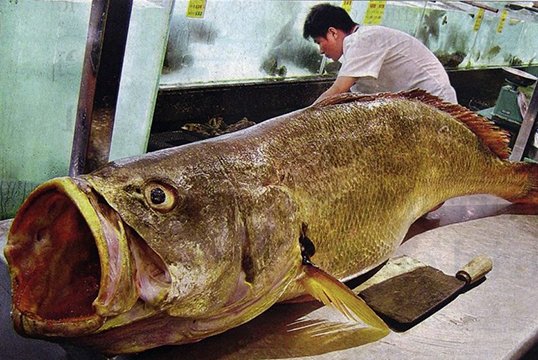This article by Zhang Chun originally appeared on chinadialogue ocean and is republished under a Creative Commons license.
 Fish maw for sale (Image: Earnest Tse)
Fish maw for sale (Image: Earnest Tse)
China’s craze for the swim bladder of the totoaba, a giant Mexican fish, has driven it close to extinction. Dubbed “aquatic cocaine”, trade in the delicacy is banned, but smuggling is still a major problem. There is new hope, however, thanks to increased awareness of the issue in China and better cooperation with both Mexico and the United States, a major transit point.
Since the beginning of 2018, Chinese customs authorities have uncovered five cases of smuggling in totoaba swim bladders, also known as fish maw. Thirty-two people have been arrested and 300 million yuan (US$45 million) worth of contraband seized.
But is this action enough to save the totoaba?
The decline of a species
In China, swim bladder is popular for its believed nutritional and medicinal properties. Sold dried, prices vary widely from a few hundred yuan per kilogramme to hundreds of thousands of yuan, depending on the species of origin. Trade in the maw of most species is not banned – selling the totoaba swim bladder, however, has been illegal since 1976, when the fish was added to the Convention on International Trade in Endangered Species of Wild Fauna and Flora (CITES).
The swim bladder of the totoaba is particularly prized due to its large size and thickness, as well as its perceived health benefits. It is not the first victim of the Chinese taste for maw. The Chinese bahaba, native to the waters off south-eastern China, has a swim bladder with similar properties. Its popularity led to market prices so high it was known as “golden maw” – by weight, it cost more than gold. This led to overfishing and a rapid decline in the species’ population. Although trade was banned on the Chinese mainland in 1989, numbers have continued to fall. In 2006 it was added to the International Union for Conservation of Nature’s (IUCN) Red List as critically endangered.
 A Chinese bahaba in 2003 (Image: Sadovy & Cheung)
A Chinese bahaba in 2003 (Image: Sadovy & Cheung)
With the bahaba nowhere to be found, China’s maw traders turned their attention to the totoaba. But the totoaba was already in crisis – in the early to mid-twentieth century, Mexico exported large quantities of the fish to the United States, where it was prized for its flesh rather than its swim bladder. By the 1970s, overfishing had led to its inclusion on the IUCN Red List. With the increased demand from China, it is now listed as critically endangered.
It is not just the totoaba that has suffered. Overfishing in the Gulf of California has also spelt disaster for a small porpoise similar in size to the totoaba. The vaquita is often accidentally caught in the fine-meshed gillnets used to catch the fish. According to the IUCN, there are currently only 18 adult vaquita still alive.
Exposing the underground trade
The plight of the totoaba and vaquita only came to international attention in 2013, when an alert customs officer triggered the first US seizure of totoaba maw at the Mexican border.
In that year a Mexican vaquita expert published research showing that existing conservation measures had failed to stop the cetacean being killed. In 2014, the Centre for Biological Diversity, a US conservation group, published an open letter calling for a ban on gillnet fishing to protect the critically endangered animal.
That letter prompted the China CITES Endangered Species Scientific Commission to take note of these distant species. “We knew they were on the CITES appendices and that trade was banned. But we hadn’t realised the connection with China,” said Zeng Yan, assistant to the director of the commission.
When China cracked its first totoaba smuggling case in 2018, it was with remote assistance from the commission. A customs official at Guilin’s international airport in south China, unsure of what he had found, sent an image to the commission’s experts and, with help from Zeng Yan, identified the contraband as totoaba maw.
“It was only during our first investigation [in 2015] that we realized there was an underground trade… Front-line commercial and customs officials haven’t necessarily seen it,” said Hua Ning, head of the ecology department at the China office of the Natural Resources Defense Council, an American advocacy group.
A joint enforcement alliance
It is hard for any one country to tackle an illegal supply chain that stretches halfway around the world. It also takes time to set up cooperative mechanisms. It was only in June 2015 that China and the US first had high-level discussions on how to tackle the smuggling.
Investigations by environmental groups helped spur action. In May 2015, Greenpeace reported totoaba maw on sale in a number of shops in Guangzhou and Hong Kong. That year saw the first official investigations, which also found specimens for sale in Hong Kong and the mainland.
At a CITES conference in October 2016, China, the US and Mexico formally proposed to protect the totoaba together.
One of the toughest challenges in policing the trade in totoaba maw is identifying it, especially at a busy customs post. To address this, in December 2016, various government bodies, including China’s State Office for the Trade in Endangered Species, and international environmental groups the Natural Resources Defense Council and WildAid, held a workshop in Guangzhou. The event was attended by over 100 people, including representatives from China’s customs, fisheries, markets and coastguard authorities.
It showcased technology that can be used to identify totoaba maw and issued a quick visual identification guide to be stored on mobile phones. Representatives from the US Fish and Wildlife Service and the Mexican environmental authorities also shared their experiences of totoaba conservation.
In July 2017, a second workshop took place in San Felipe, Mexico, close to the habitats of the totoaba and vaquita. Both of these training initiatives were key in enabling the Chinese customs authorities to crack their first totoaba smuggling operation the following year.

What’s next?
With better policing, there is a risk that totoaba maw smuggling is now moving further underground, according to Bonnie Tang a campaigner with Greenpeace Hong Kong.
In Hong Kong, only one case of totoaba maw smuggling has resulted in charges since 2015. Minutes taken from a 2017 meeting of the Hong Kong Agriculture, Fisheries and Conservation Department’s Endangered Species Advisory Committee show no totoaba swim bladder was found in the region from its first discovery in 2015 to the end of 2016.
But the trade has not stopped. Gary Stokes, former director of Sea Shepherd Asia, relates that two German filmmakers hoping to document the illegal totoaba trade had, on his recommendation, visited Macau. Within four hours they found someone willing to sell them top-grade totoaba maw. They were shown pictures of the goods, which were said to be in Hong Kong, and were told it would be no problem to have them shipped over.
Despite this, Bonnie Tang thinks the increased enforcement by China’s customs authorities is sending a crucial signal to both traders and consumers. Greater media coverage is also helping people understand the impact of totoaba swim bladder consumption. Such public awareness is crucial, as online communication and easier travel continue to boost its popularity as a “nutritional” food.
This will no doubt help another species of fish currently threatened by China’s hunger for swim bladder, the Nile perch. But for Mexico’s vaquita, so close to the precipice of extinction, much more needs to be done. “We can’t save the vaquita just by tackling fish maw smuggling,” said Zeng Yan, pointing out that habitat protection is also crucial.
“Only they [the countries of origin] can ensure a species is able to survive in its natural habitat,” she added.

